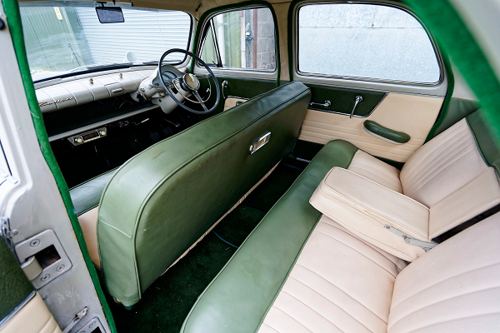For Connoisseurs of Motoring – Ten Facts About The Ford Zephyr-Zodiac
07 March 2025
This 1955 Canterbury Green and Dorchester Grey Zephyr-Zodiac vividly reminds me of a description I once wrote in Classics Monthly. When new, the flagship of Ford GB’s line-up seemed “as up to the minute as an Eastmancolor film starring Diana Dors and an object of desire for any Edwardian-suited youths who queued to jive to Ken Mackintosh and His Band at the Southampton Gaumont”.

And Ford seemed to perfectly time the Zodiac’s debut in October 1953, for many British motorists could feel a certain amount of optimism. February of that year marked the end of government-controlled ‘Pool Petrol’. A buyer could now place an order without joining a waiting list of years for their new Zodiac. 1953 also saw the end of the new car covenant, which obliged a motorist not to sell it for at least 24 months.

Meanwhile, food rationing would cease by 1954, new office buildings were emerging on former bomb sites, and the Zodiac appeared to symbolise the end of post-war austerity. By the middle of the decade, it was the car of choice for property developers, film stars and anyone who wished to be part of the emerging affluent society. Here are ten facts about this key post-war Dagenham product:

- Ford GB promoted the Zephyr-Zodiac as “a new luxury version of the famous model that won the 1953 Monte Carlo Rally”.
- Furthermore, the Zephyr-Zodiac was made “for connoisseurs of motoring; it is a leader amongst cars of today, built to deserve the instant admiration it will always command” and “a picture of grace, poise and purpose!”.
- The Zephyr-Zodiac’s £851 2s 6d price made it “within reach of those who would otherwise consider such motoring beyond their means”.
- Compared with its Zephyr Six stablemate, the Zodiac’s equipment list was indeed lavish. Whitewall tyres, duotone paintwork, exterior trim plated in nine-carat gold, wool headlining, leather upholstery, pile carpet, wool headlining, fog, spot and reversing lamps could all be yours. Not to mention a heater, windscreen washers, wing mirrors, a cigar lighter, and a roof-mounted clock.
- To put such luxuries in context, the 1953 London Motor Show also marked the debut of the new Ford Popular 103E, which came sans heater, indicators, sun visors, ashtrays, an adjustable front passenger seat and even a boot floor.
- The Zodiac had a higher compression ratio for the 2,262cc, straight-six-cylinder engine. than the Zephyr to compensate for the additional weight of its fittings. Its top speed was 84 mph with 0-60 in just over 20 seconds – ideal for “the businessman, anxious to reduce travelling time to a minimum”.
- Autocar thought: “Customary reaction to the Zodiac is that of admiration, and the owner who likes to have a car that is distinctive, as well as lively in performance, can consider the price difference between the standard Zephyr Six and the Zodiac to be well worth while”.
- Motor Sport regarded the Zodiac as the best in its price class. Their editor, Bill Boddy, wrote, “We were soon affectionately referring to it as ‘Zsa Zodiac’ because it is that sort of car”.
- In terms of six-cylinder rivals, 1954 saw the debut of the E-Series Vauxhall Cresta, which cost £844 0s 10d.
- Dave King, Daniel Massey, and Norman Rossington steal a 1955 Zephyr-Zodiac rather than a Facel Vega HK500 in the 1962 comedy film Go to Blazes as British cars are “easier to trade in”!

With thanks to https://www.carandclassic.com/ for their time and permission to use the images in this blog.
